seat adjustment AUDI Q7 2010 Owner´s Manual
[x] Cancel search | Manufacturer: AUDI, Model Year: 2010, Model line: Q7, Model: AUDI Q7 2010Pages: 390, PDF Size: 93.04 MB
Page 85 of 390
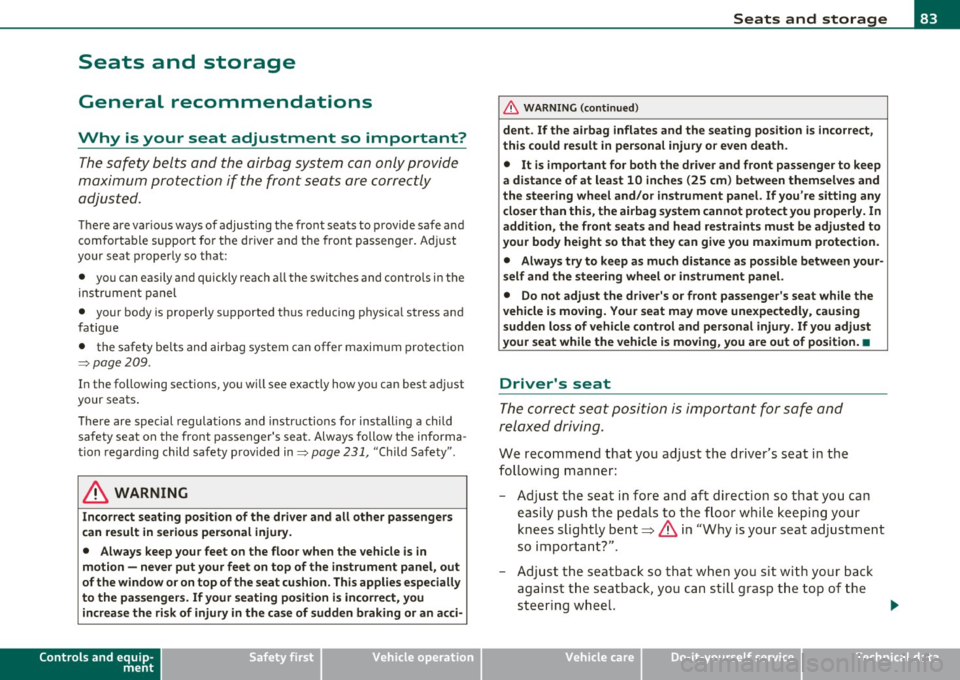
Seats and storage
General recommendations
Why is your seat adjustment so important?
The safety belts and the airbag system can only provide
maximum protection if the front seats are correctly
adju sted.
Th ere a re various ways of adjusting t he front seats to provide safe and
comfortable support for the driver and the front passenger . Ad just
your seat properly so that :
• you can easily and quickly reach a ll the switc hes and contro ls in the
ins trumen t pa nel
• your body is properly supported thus reducing phys ica l stress and
fatigue
• the safety be lts and airbag system can offer maximum protection
=>
page 209 .
In the following sections, you w ill see exact ly how you can best ad just
your sea ts .
Th ere are special regulations a nd instr uctions for install ing a child
safety seat on the front passenger's sea t. Always follow the informa
tion regarding child safety p rovided in=>
page 231, "Child Safety ".
& WARNING
Incorrect seating posit ion of the dri ver and all other passengers
can result in seriou s personal injury.
• Always keep your feet on the floor when the vehicle is in
motion -never put your feet on top of the instrument panel, out
of the window o r on top of the seat cush ion. This applies especially
to the passengers.
If your seating po sition is incorrect, you
increase the ri sk of injury in the case of sudden braking or an acci-
Controls and equip
ment Safety first
Seats and storage
& WARNING
(con tinu ed)
dent . If the airbag inflates and the seating position is incorrect ,
this could result in per sonal injury or even death .
• It is important for both the dri ver and front passenger to keep
a distan ce of at least 10 inche s (25 cm) between themselves and
the steering wheel and /or instrument panel. If you 're sitting any
closer than this , the airbag system cannot protect you properly. In
addition, the front seats and head restraints must be adjusted to
your body height so that they can give you maximum protection .
• Always try to keep as much distance as possible between your
self and the steering wheel or instrument panel.
• Do not adjust the driver's or front passenger 's seat while the
vehicle is moving. You r seat may move unexpectedly , causing
sudden loss of vehicle control and personal injury . If you adjust
your seat while the vehicle is moving , you are out of position. •
Driver's seat
The correct seat position is important for saf e and
re lax ed driving.
W e recomme nd that you a djust the drive r's sea t in the
f ollowing man ner :
- Ad just the seat in fore and aft direction so that you can
easily pus h the pedals to the floor w hile keeping your
knees slightly bent=>
& in "Why is yo ur seat a djus tme nt
so importa nt?" .
- Adjust the seatback so that when yo u sit with yo ur back
agai nst t he seatback , you can st ill grasp t he top of the
steering w heel. ..,
Vehicle care Technical data
Page 86 of 390
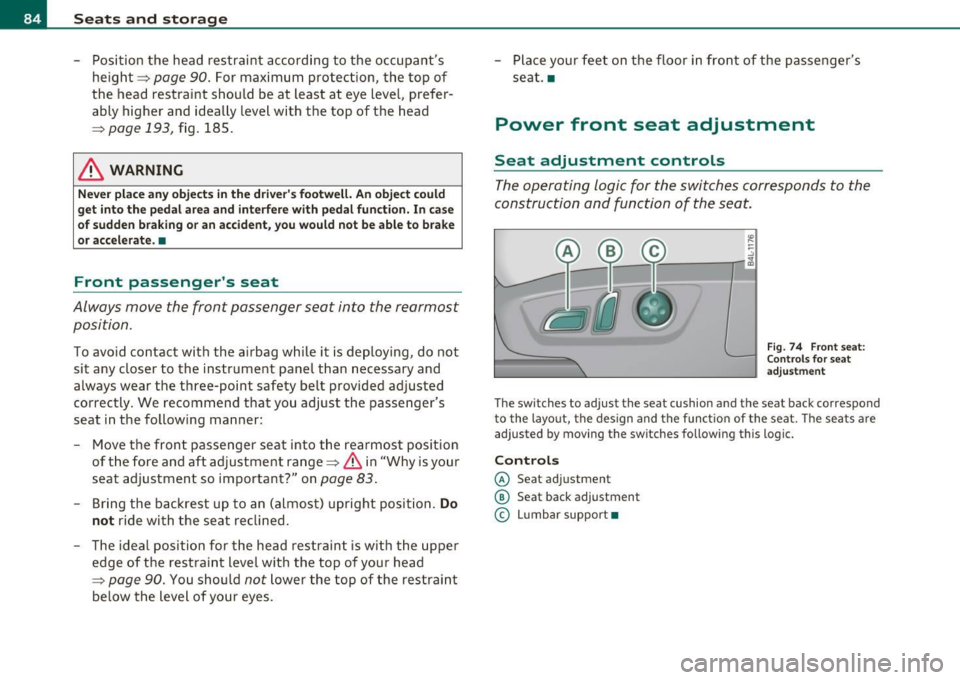
Seats and storage
-Position the head restraint according to the occupant's
height=>
page 90. For maximum protection, the top of
the head restraint should be at least at eye level, prefer
ably higher and ideally level with the top of the head
=>
page 193, fig. 185.
& WARNING
Never place any objects in the driver's footwell. An object could
get into the pedal area and interfere with pedal function. In case
of sudden braking or an accident, you would not be able to brake
or accelerate. •
Front passenger's seat
Always move the front passenger seat into the rearmost
position.
To avoid contact with the airbag while it is deploying, do not
sit any closer to the instrument panel than necessary and
always wear the three-point safety belt provided adjusted
correctly. We recommend that you adjust the passenger's
seat in the following manner:
- Move the front passenger seat into the rearmost position
of the fore and aft adjustment range=>
& in "Why is your
seat adjustment so important?" on
page 83.
- Bring the backrest up to an (almost) upright position. Do
not ride with the seat reclined.
- The ideal position for the head restraint is with the upper
edge of the restraint level with the top of your head
=>
page 90. You should not lower the top of the restraint
below the level of your eyes. -
Place your feet on the floor in front of the passenger's
seat. •
Power front seat adjustment
Seat adjustment controls
The operating logic for the switches corresponds to the
construction and function of the seat.
ie ~ ~ ..!J
-----r -aal
Fig. 74 Front seat:
Controls for seat
adjustment
The switches to adjust the seat cushion and the seat back correspond
to the layout, the design and the function of the seat. The seats are
adjusted by moving the switches following this logic.
Controls
© Seat adjustment
@ Seat back adjustment
© Lumbar support •
Page 87 of 390

Adjusting the seat
Position, angle and shape of the seat can be adjusted
electrically to ensure safe and comfortable seating.
Read and follow the warning notices=> & before you adjust
your seat .
Fore-and-aft adjustment
- Push the switch@ forward or backward=> page 84,
fig. 74.
Adjusting seat height
-Pull or push the switch@ up or down.
Front seat cushion up/ down
-Press the switch@ at the front up or down.
Rear seat cushion up/ down
-Press the switch@ at the rear up or down.
Adjusting seat back angle
-Push the switch @forward or backward .
Adjusting the curvature of the lumbar
support
- Push the switch plate © forward or backward to increase
or reduce the curvature.
Adjusting the height of the lumbar support
- Push the switch plate © up or down to position the curva
ture higher or lower.
Controls and equip
ment Safety first
Seats and storage
& WARNING
•
Adjust the driver's seat only when the vehicle is stationary. You
risk an accident otherwise.
• The power adjustment for the front seats also works with the
ignition switched off or with the ignition key removed. For this reason, children should never be left unattended in the vehicle -
they could be injured!
• Exercise caution when adjusting the seat height. Unsupervised
or careless seat adjustment can pinch fingers or hands causing
injuries.
• While the vehicle is moving, the seat backs of the front seats
must not be inclined too far to the rear because the effectiveness
of the safety belts and the airbag system is severely compromised
- there is a risk of injury.
• To reduce the risk of injury
in the case of sudden braking or
accident, front passengers must never ride in a moving vehicle
with the seatback reclined. Safety belts and the airbag system
only offer maximum protection when the seatback is upright and
the safety belts are properly positioned on the body. The more the
seatback is reclined, the greater the risk of personal injury from an
incorrect seating position and improperly positioned safety
belts. •
Vehicle care Technical data
Page 88 of 390
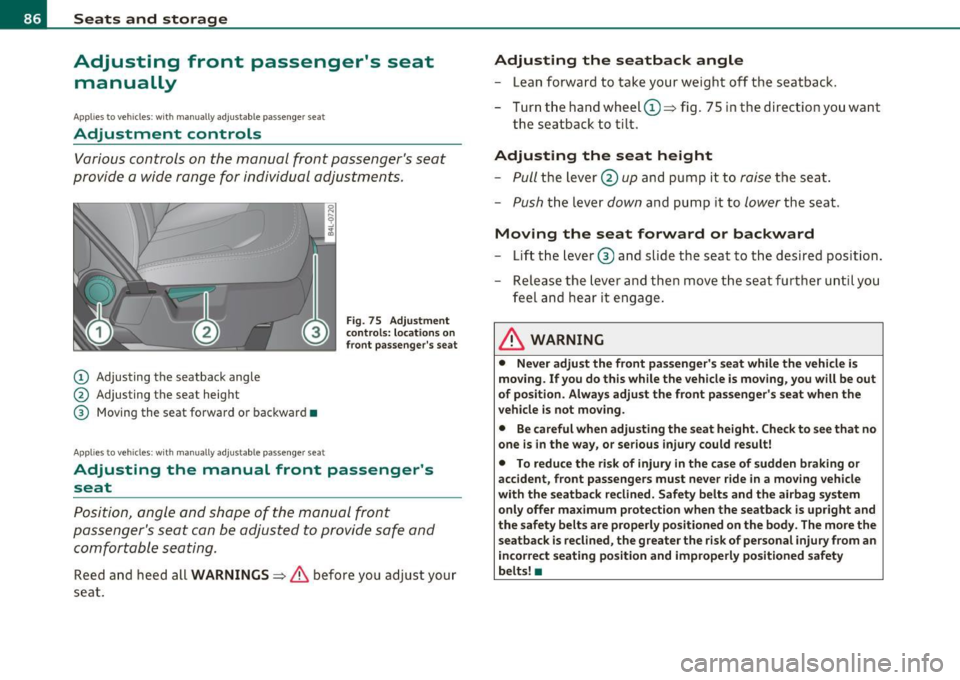
Seats and storage
Adjusting front passenger's seat manually
Applies to vehicl es: with manua lly adjustab le passenger seat
Adjustment controls
Various controls on the manual front passenger's seat
provide a wide range for individual adjustments.
(D Adjusting the seatback angle
@ Adjusting the seat height
® Moving the seat forward or backward •
Applies to veh icles : w ith manually adjustable passenger seat
Fig . 75 Adjustment
controls: locations on
front passenger's seat
Adjusting the manual front passenger's
seat
Position, angle and shape of the manual front
passenger's seat can be adjusted to provide safe and
comfortable seating.
Reed and heed all WARNINGS :::;, & before you adjust your
seat.
Adjusting the seatback angle
- Lean forward to take your weight off the seatback.
- Turn the hand wheel(D:::;, fig . 75 in the direction you want
the seatback to tilt .
Adjusting the seat height
-Pull the lever @up and pump it to raise the seat.
-Push the lever down and pump it to lower the seat.
Moving the seat forward or backward
- Lift the lever® and slide the seat to the desired position.
- Release the lever and then move the seat further until you
feel and hear it engage.
& WARNING
• Never adjust the front passenger's seat while the vehicle is
moving. If you do this while the vehicle is moving, you will be out
of position. Always adjust the front passenger's seat when the
vehicle is not moving.
• Be careful when adjusting the seat height. Check to see that no
one is in the way, or serious injury could result!
• To reduce the risk of injury in the case of sudden braking or
accident, front passengers must never ride in a moving vehicle
with the seatback reclined. Safety belts and the airbag system
only offer maximum protection when the seatback is upright and
the safety belts are properly positioned on the body. The more the
seatback is reclined, the greater the risk of personal injury from an
incorrect seating position and improperly positioned safety
belts! •
Page 89 of 390
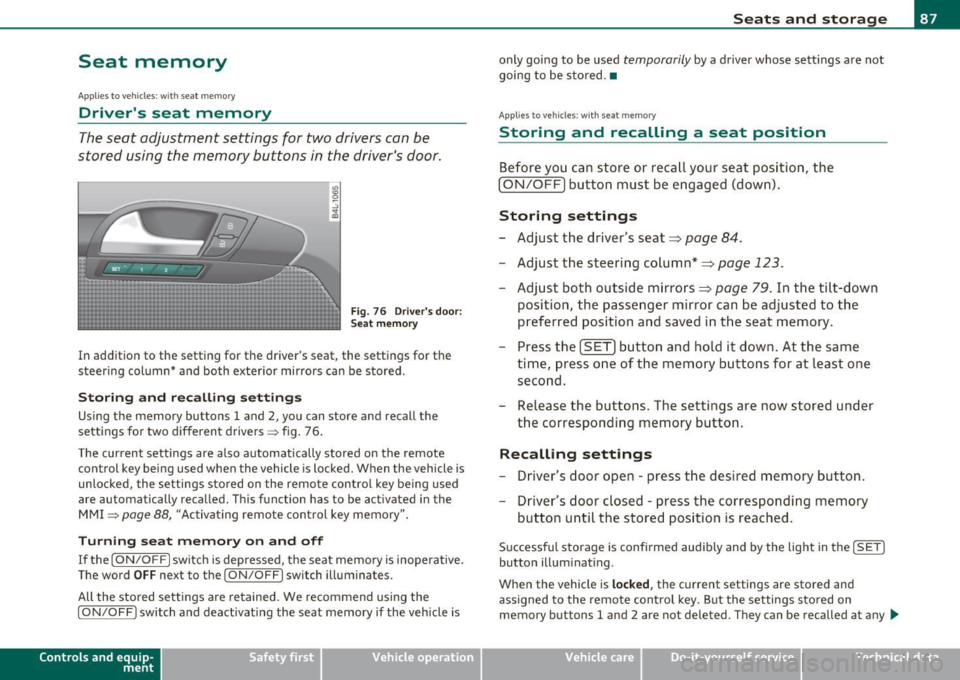
Seat memory
Applies to veh icles: with seat memory
Driver's seat memory
The seat adjustment settings for two drivers can be
stored using the memory buttons in the driver's door.
Fig . 76 Driver's door:
Seat memory
In addition to the setting for the driver's seat, the settings for the
steering column* and both exterior mirrors can be stored.
Storing and re calli ng setting s
Using the memory buttons 1 and 2, you can store and recall the
settings for two different drivers => fig . 76 .
T he current settings are also automatically stored on the remote
control key being used when the vehicle is locked. When the vehicle is
unlocked, the settings stored on the remote contro l key being used
a re automatically recalled. This function has to be activated in the
MMI
=> page 88, "Activat ing remote control key memory ".
T urning se at m em ory on and off
If the [ ON/OFF] switch is depressed , the seat memory is inoperative .
The word
OFF next to the [ ON/OFF] switch illuminates.
All the stored settings are retained. We recommend using the
[ ON/OFF ] switch and deact ivat ing the seat memory if the vehicle is
Con tro ls a nd e quip
m en t Vehicle
OP-eration
Seats and storage
only going to be used temporarily by a driver whose settings are not
going to be stored .•
App lies to vehi cles : w it h seat memo ry
Storing and recalling a seat position
Before you can store or recall your seat position, the
(ON/OFF) button must be engaged (down) .
Storing settings
-Adjust the driver 's seat => page 84.
- Adjust the steering column*=> page 123.
Adjust both outside mirrors=> page 79. In the tilt -down
position, the passenger mirror can be adjusted to the
preferred position and saved in the seat memory.
- Press the
(SET) button and hold it down. At the same
time, press one of the memory buttons for at least one second.
- Release the buttons. The settings are now stored under
the corresponding memory button.
Rec alling settings
- Driver's door open -press the desired memory button.
- Driver's door closed -press the corresponding memory
button until the stored position is reached .
Successful storage is confirmed audib ly and by the light in the [ SET]
button illuminating.
When the vehicle is
loc ked , the current settings are stored and
assigned to the remote control key. But the settings stored on
memory buttons 1 and 2 are not deleted. They can be recalled at any
~
Vehicle care Do-it-yourselt service iTechnical data
Page 90 of 390

Seats and storage
time. When the vehicle is unlocked , the settings stored on the
remote con trol key are res to red .
If your veh icle is d riven by other persons using yo ur remote cont rol
key, you should save your individua l seat position on one of the
memo ry buttons. Yo u can rec all you r settings ag ain sim ply and
conveniently by press ing the corresponding memory button. When
t he vehi cle i s loc ked , the se se ttings a re a utomat ic a lly re-assig ned to
the remote control key and stored .
& WARNING
• For safety reasons , the seat setting can only be recalled when
the vehicle is stationary -otherwi se you risk having an accident .
• In an emergency , the recall operation can be stopped by
pressing the [
ON/OFF] button or by briefly pre ssing any given
memory button. •
Applie s to v ehicle s: w it h sea t m em ory
Activating remote control key memory
To be able to re ca ll the store d settings with the rem ote
c ontrol key, the func tion has to be activat ed in th e MMI.
- S elect : Fu nct ion button I C AR] > Systems*> Seat
adjustment
> Driver's seat > Key mem. profile > On. •
Rear seats
General information
Safe tran sportatio n of p asse nge rs on the re ar sea ts
r e q uir es pr op er safe ty pre caution s.
All passengers on the rear seats must be seated in compliance with
t he s afety gui deli nes e xplained in=>
page 199 and => page 209. The correct seating position is crit
ica l for the safety of front
and rear seat
p assenge rs alik e=>
page 192.
& WARNING
• Occupants in the front and rear seat s must always be properly
restrained .
• Do not let anyone ride in the vehicle without the head
restraints provided . Head rest raints help to reduce injuries .
• Loose items inside the passenger compartment, can fly
fo rwa rd in a crash or sudden maneuver and injure occupants.
Always store articles in the luggage compartment and use the
fastening eyes, especially when the rear seat backs have been
folded down.
• Read and heed all WARNINGS =>
page 192, "Proper seating
positions for passengers in rear seats ".•
Adjusting seat (second row seating)
Th e fo re-and-aft adjustment * of the seat cushion and the
sea t ba ck an gle can be adjusted .
Fig. 77 Adju sting seat
back ang le ..,.
Page 91 of 390
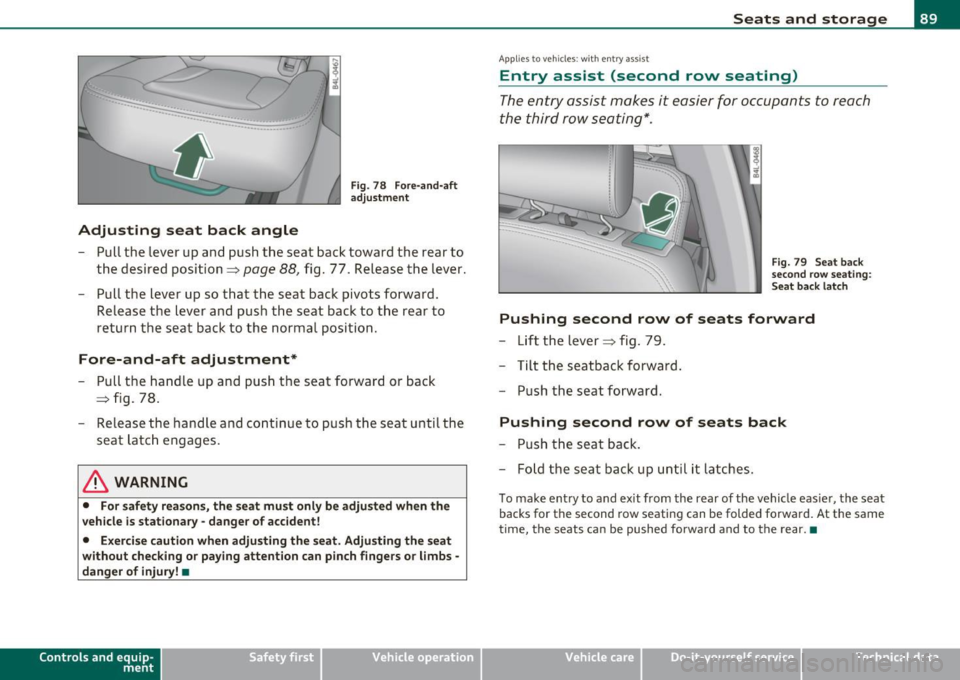
....
~....-'""-~_3-:>--.....,__~~ :
······--... __ ;::::.:_ :::--~
Adjusting seat back angle
Fig . 78 Fore -and -af t
adju stme nt
- Pull the lever up an d push the seat bac k toward t he rear to
t h e desi red position ==>
page 88, fig. 77. Release the lever.
- Pull t he lever up so that the seat back pivots forward.
Release t he lever and pus h the seat back to the rear to
retu rn t he sea t bac k to the norma l position.
Fore-and-aft adjustment*
- Pull t he ha ndle up and push the seat forward or back
==> fig. 78.
- Releas e the handle a nd cont inue to p ush th e seat u ntil the
sea t latc h engages.
& WARNING
• For safety rea son s, the seat mu st only be adjusted when the
vehicle is stationary · danger of accident!
• Exerci se caution when adjusting the seat . Adju sting the seat
without checking or paying attention c an pinch finge rs or limbs·
danger of injury! •
Con trol s and equ ip
m ent Vehicle
OP-eration
Seats and storage
Applies to ve hicles : with e ntry assist
Entry assist (second row seating)
The entry assist makes it easier for occupants to reach
the third row seating*.
Fig. 79 Seat back
s e co nd r ow sea ting :
S eat back lat ch
Pushing second row of seats forward
- Lift the lever==> fig . 79.
- Tilt the s eatback forwa rd .
- Pu sh the seat forward.
Pushing second row of seats back
-Push the seat back.
- Fo ld the seat back u p un til it latches.
T o make en try to and ex it from the rear of the vehi cle eas ie r, the seat
backs for th e se cond row seating can be folded fo rwa rd. At the sam e
time, the seats ca n be pushed forwa rd and to the rear. •
Vehicle care Do-it-yourselt service iTechnical data
Page 93 of 390
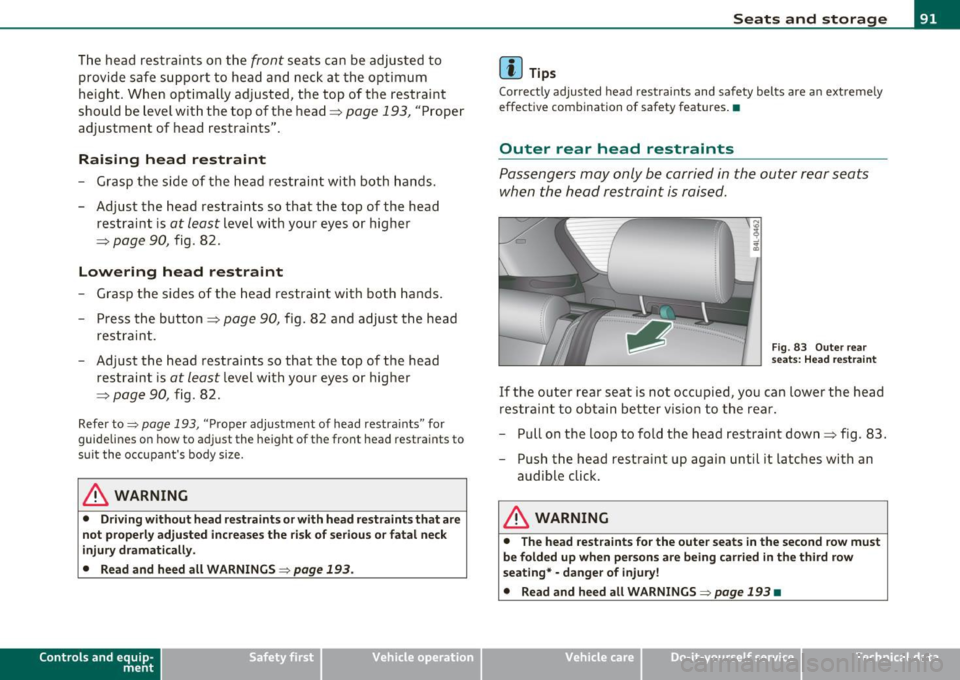
The head restraints on the front seats can be adjusted to
provide safe support to head and neck at the optimum
height. When optimally adjusted, the top of the restraint
should be level with the top of the head~
page 193, "Proper
adjustment of head restraints".
Raising head restraint
- Grasp the side of the head restraint with both hands.
- Adjust the head restraints so that the top of the head
restraint is
at least level with your eyes or higher
~ page 90, fig. 82.
Lowering head restraint
-Grasp the sides of the head restraint with both hands.
Press the button~
page 90, fig. 82 and adjust the head
restraint.
- Adjust the head restraints so that the top of the head
restraint is
at least level with your eyes or higher
~ page 90, fig. 82.
Refer to::::;, page 193, ''Proper adjustment of head restraints" for
guidelines on how to adjust the height of the front head restraints to
suit the occupant's body size.
& WARNING
• Driving without head restraints or with head restraints that are
not properly adjusted increases the risk of serious or fatal neck
injury dramatically.
• Read and heed all WARNINGS:::::>
page 193.
Contro ls a nd e quip
m en t Vehicle
OP-eration
Seats and storage
(I) Tips
Correctly adjusted head restraints and safety belts are an extremely
effective combination of safety features.•
Outer rear head restraints
Passengers may only be carried in the outer rear seats
when the head restraint is raised.
Fig . 83 Outer rear
seats: Head restraint
If the outer rear seat is not occupied, you can lower the head
restraint to obtain better vision to the rear.
- Pull on the loop to fold the head restraint down~ fig. 83.
- Push the head restraint up again until it latches with an
audible click.
& WARNING
• The head restraints for the outer seats in the second row must
be folded up when persons are being carried in the third row
seating*· danger of injury!
• Read and heed all WARNINGS:::::>
page 193 •
Vehicle care Do-it-yourselt service iTechnical data
Page 121 of 390
![AUDI Q7 2010 Owner´s Manual _______________________________________________ w __ a _r _m _ a_ n_d _ c_o _ l_ d __ _
App lies to veh icles : with di esel e ngine
Supplementary heater
- Select: Function button !CAR]> C AUDI Q7 2010 Owner´s Manual _______________________________________________ w __ a _r _m _ a_ n_d _ c_o _ l_ d __ _
App lies to veh icles : with di esel e ngine
Supplementary heater
- Select: Function button !CAR]> C](/img/6/40275/w960_40275-120.png)
_______________________________________________ w __ a _r _m _ a_ n_d _ c_o _ l_ d __ _
App lies to veh icles : with di esel e ngine
Supplementary heater
- Select: Function button !CAR]> Control button AC>
Suppl. heater .
Vehicles with diesel engines are equipped with a supplementary
heater to warm the inte rior of the veh icle more qu ickly. The supple
mentary heater switches itself on and off automatically when the
outs ide temperature is below SO
°F (10 °() and the engine is running,
depending on the coolant temperature, interior temperature and the
selected temperature. •
Applies to veh icles: w ith four -zone automat ic co mfort air co nditioning
Rear operation
The air conditioning in the rear of the vehicle can be
controlled from the cockpit.
-Select: Function button I CAR]> Control button AC> Rear
operation.
Th e d river or front passenger can contro l the air conditioning in the
rea r of the vehicle using
his/her own controls. •
Heated Seats
Applies to vehicles: with ele ctrica lly heated front seats
Heated front seats ~
The seat cushion and the seat back of the front seats can
be heated electrically.
- Press the~ button.
- Rotate the regulator to the desired setting.
Controls and equip
ment Safety first
I
n position O the heating for the seats is turned off. The range of
adjustment is between 1 and 6.
The heater for the front seats can be turned on when the weight of
the particular seat's occupant is detected. However, the front seats
can be pre -heated for about 10 minutes using the activated seat
heater. After this time has e lapsed, the seat heater automatic ally
turns off if it does not detect an occupant's weight for the particular
seat.
0 Note
To avoid damage to the heating elements in the seats, do not kneel
on the seats or p lace heavy loads on a small area of the seat.
[I] Tips
Please note that the weight of objects placed on the seat wi ll also be
detected. This weight may be enough to cause the seat heater to turn
on. •
Applies to vehicles: w it h front seat ventilat ion
Front seat ventilation [~]
The seat cushion and the seat backrest on the front seats
can be ventilated .
-Press the Iv] button .
- Rotate the regulator to the desired setting.
When the regulator is in the O position, the seat ventilat ion is
switched off . The range of adjustment is between 1 and 6. •
Vehicle care Technical data
Page 122 of 390
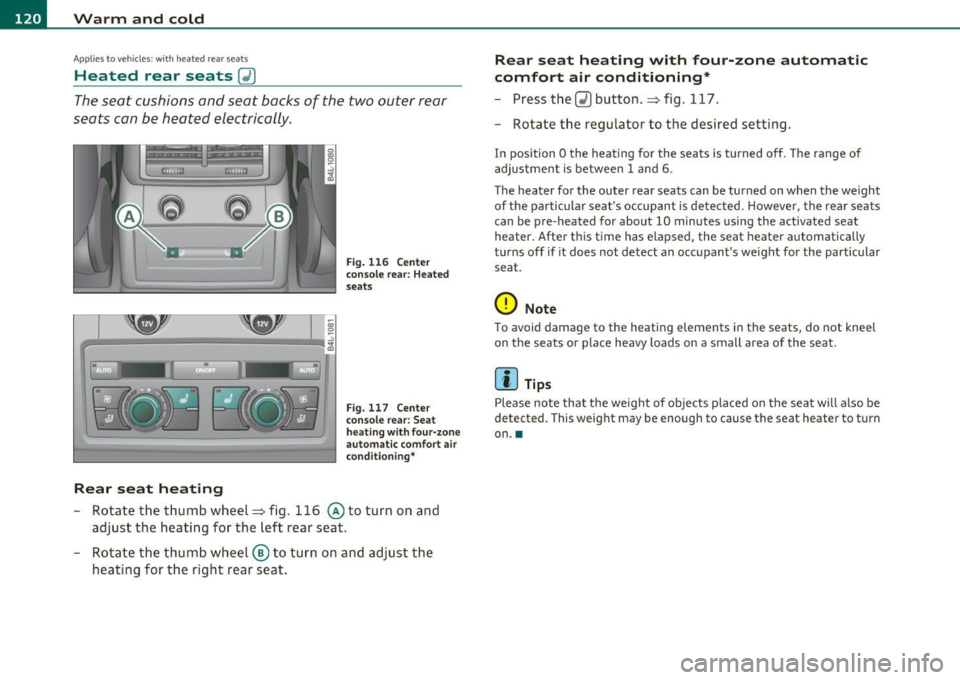
1111..__w __ a _r _m __ a_n _ d_ c_ o_ ld ________________________________________________ _
Applie s to vehicles : wi th heated rear seats
Heated rear seats [JI
The seat cushions and seat backs of the two outer rear
seats can be heated electrically.
Re ar seat heating
Fig. 116 Ce nter
conso le rear: Heated
seats
Fig. 117 Ce nter
console rear: Seat
h eat ing wit h fo ur-zone
automa tic comfort air
condi tion ing *
-Rotate the thumb wheel~ fig. 116 @to turn on and
adjust the heating for the left rear seat.
- Rotate the thumb wheel ® to turn on and adjust the
heating for the right rear seat.
Rear seat heating w ith four -zone autom atic
comfo rt air conditioning *
-Press the Q) button .~ fig. 117.
- Rotate the regulator to the desired setting.
In position O the heating for the seats is turned off. The range of
adjustment is between
1 and 6.
The heater for the outer rear seats can be turned on when the weight
of the particular seat's occupant is detected. However, the rear seats
can be pre-heated for about
10 minutes using the activated seat
heater. After this time has elapsed, the seat heater automatically
turns off if it does not detect an occupant's weight for the particular
seat.
0 Note
To avoid damage to the heating elements in the seats, do not kneel
on the seats or place heavy loads on a small area of the seat.
[I] Tips
Please note that the weight of objects placed on the seat will also be
detected . This weight may be enough to cause the seat heater to turn
on .•